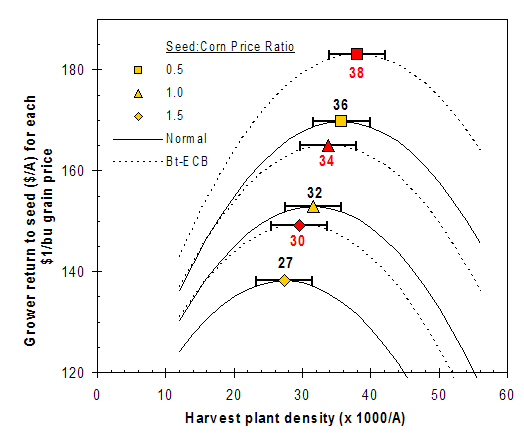Managing Corn Seed Costs: Bt-ECB Hybrids
May 11, 2006
Joe Lauer and Trenton Stanger
Corn Agronomist and Research Associate
Bt corn hybrids resist European corn borer (ECB) damage and lodge less, creating
interest among growers, agronomists, and seed companies in their yield response
to increasing plant density. Numerous studies have concluded that the plant density
for maximum corn grain yield has been increasing over time. Current UW recommendations
for harvest plant densities range between 26,000 to 30,000 plants/A.
Lodging is a major constraint to maximizing grain yields in modern corn production.
High incidence of lodging is one of the hazards of increasing plant densities to
get maximum yields.
Frequency of drought is a concern that might deter a producer from increasing plant
density. Newer hybrids appear to have improved ability to resist barrenness and
other types of injury associated with high plant densities. Consequently, there
appears to be minimum risk associated with planting high densities in a dry year
other than additional seed costs. It is a bigger risk not planting to the environment's
maximum potential.
The plant density where yield is maximized for Bt corn should be higher than non-Bt
corn because of the reduced potential for stalk lodging, and especially when subjected
to ECB damage. From 2002 to 2004, Bt and non-Bt corn hybrids were planted at plant
densities ranging from 25,000 to 50,000 plants/A in 5000 to 6000 plants/A increments
at 10 locations in Wisconsin.
Regardless of corn hybrid trait, this study identified the plant density that maximized
yield to be approximately 41,400 plants/A. Further, the plant density maximizing
yield for Bt hybrids was 42,300 plants/A while for non-Bt hybrids was 40,000 plants/A.
If plant densities were increased from 30,000 plants/A to 41,400 plants/A,
yields increased 4.2%.
At the same plant density, Bt corn hybrids yield more than non-Bt corn but seed
costs of Bt corn are often greater than non-Bt seed. The seed:corn price ratio is
slightly higher for Bt corn (see "Managing corn
seed costs" Wisconsin Crop Manager 13(8):58-59).
For Bt and non-Bt corn where the seed:corn price ratios are the same, as seed costs
increase and/or corn prices decrease the economic optimum plant density EOPD) decreases
(Figure 1). For example, the EOPD for a ratio of 1.50 = 29,600 plants/A for Bt corn
and 27,300 plants/A for non-Bt corn. As seed cost decreases and/or corn price increases
(ratio = 0.50) the EOPD increases to 38,100 plants/A for Bt corn and 35,800 plants/A
for non-Bt corn.
Corn management systems must be justified on the basis of economic returns, rather
than on crop yield alone. Overall, Bt corn hybrids in this study yielded 6.6% greater
and had 22% less lodging than non-Bt hybrids. However, the yield and lodging benefits
for Bt hybrids were offset by the higher seed and harvest costs associated with
Bt corn, adding no economic benefit. This study determined the EOPD to be 33,900
plants/A (regardless of hybrid trait) or 3900 plants/A more than the current recommendation
in Wisconsin. Even though no economic benefit was measured for Bt corn due to higher
seed costs, other benefits such as safety (pesticide handling), insurance (potential
for ECB outbreaks), and "peace of mind" might be important for growers to consider
when using Bt corn.

Figure 1. Profitable harvest plant densities of Bt and non-Bt corn hybrids for seed:corn
price ratios of 0.5, 1.0, and 1.5. Symbols represent the economic optimum return
to plant density (EOPD) and error bars are the low and high ends of the range of
profitability (within $1/A of EOPD) at each seed:corn price ratio.